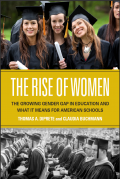Main navigation
 Last week, we shared data from our new book, The Rise of Women, about the persistence of gender segregation in higher education. The trend is a puzzling one: women have made extraordinary gains at all levels of education over the past fifty years, but they are still underrepresented in engineering and the physical sciences (and overrepresented in the social sciences and humanities). More worryingly, gender persistence in academic majors has remained relatively stable for the past two decades.
Last week, we shared data from our new book, The Rise of Women, about the persistence of gender segregation in higher education. The trend is a puzzling one: women have made extraordinary gains at all levels of education over the past fifty years, but they are still underrepresented in engineering and the physical sciences (and overrepresented in the social sciences and humanities). More worryingly, gender persistence in academic majors has remained relatively stable for the past two decades.
Why don't more women choose to major in the so-called STEM fields (Science, Technology, Engineering and Mathematics)? In chapter eight of the book, authors Claudia Buchmann and Thomas DiPrete examine several prominent theories (presented below). Their own analysis shows that the high school years are crucial to understanding trends in gender segregation. Between grades 8 and 12, girls tend to lose interest in the sciences, possibly because of prevailing stereotypes that link ability in sciences with masculine identity. They suggest that science-intensive high schools could make a big difference: "Some schools may do an especially good job of eroding common stereotypes that link majoring in a STEM field with masculine identity. Recent evidence suggests that schools with strong science and math curricula are particularly good at delinking STEM fields from masculine stereotypes."
Here are the major arguments they make in the chapter:
1. Gender Segregation in Majors Is Not About Intellectual Ability
Using data from HSB, NELS, and ELS, Mann and DiPrete (2012) found that math test scores explain even less of the gender gap in physical science and engineering majors than was found in the College and Beyond data analyzed by Turner and Bowen (1999). Yu Xie and Kimberlee Shauman (2003) similarly assessed the most commonly asserted causes for women’s underrepresentation in the hard sciences and engineering fields. Like Turner and Bowen (1999), Xie and Shauman concluded that the gender differences in science majors are not due to gender differences in math ability or math training in high school, since these gaps have closed. Nor are they due to girls’ lower participation in high school math and science course work.[...] These findings are consistent with other studies that also find gender differences in math and science achievement, as indicated by standardized tests, to be too small to explain gender differences in math and science education or occupations (Hyde 2005; Hyde et al. 2008; Spelke 2005).
2. Girls Are Not Necessarily Driven by Different Career "Values"
[Recent] research suggests that gender differences in values have little power to explain gender differences in choice of college major. As Mann and DiPrete (2012) note, values related to career-family conflict have not impeded the trend to full gender equality in law and medical schools, even if gender segregation persists in the choice of specialties within these two professions. In a direct assessment of the role of values in choice of major, Mann and DiPrete used data from HSB, NELS, and ELS to assess the impact of three dimensions of values: aspirations toward having a family, the importance of money and success, and the importance of helping others. They found that students who value the importance of helping others and who have stronger family aspirations are less likely to major in the physical sciences or engineering, while those who value the importance of helping others are more likely to major in the biological sciences. However, these effects were small; they accounted for very little of the gender difference in majoring in STEM versus non-STEM fields and also very little of the gender difference in the distribution of majors within STEM fields.
3. For Girls Interested in STEM Fields, The Career 'Pipeline' Is Not That Leaky
Much prior research on the underrepresentation of women in science uses a “pipeline” framework, which posits a structured sequence of educational and career stages constituting a science career. This literature examines whether and at what stages education and work environments contribute to the “leaking” of women from science. It concludes that women have higher rates of attrition than men at each stage in the pipeline (Berryman 1983).[...] Legewie and DiPrete (2012a) reexamined Xie and Shauman’s (2003) “pathways” analysis to locate the sources of the gender gap in science majors in terms of earlier expressed preferences and behaviors for a more recent sample of students with NELS data. [...] Differences in persistence (the so-called leaky pipeline) account for less than 2 percent of the overall gender gap in STEM majors. The problem is not that the pipeline leaks, but rather that a relatively small fraction of women express an interest in STEM fields (particularly physical science and engineering) while in high school.
4. Rigorous High Schools Can Make a Big Difference
Legewie and DiPrete (2012a) found strong evidence that high school environments play an important role in the STEM orientations of students during the adolescent years, when these orientations are most likely to form, even net of controls for middle school achievement and orientations. As they predicted, the effects of the local environment are stronger for girls than for boys. Generally speaking, a science-intensive school environment stimulates interest in science. Interestingly, however, it also reduces the power of gender stereotypes concerning STEM fields, because girls are more strongly influenced by science-intensive environments than boys are. Local environmental effects are quite strong: if the impact on STEM orientations of the top third of high schools were extended to the rest of the high schools, the size of the STEM gap in bachelor’s degrees would be reduced by 25 percent.





